The Panzer 38(t) Tank
This German Panzer 38(t) Tank can be found at the For Freedom Museum, Ramshapellestraat 91-93, 8301 knokke-Heist, Belgium. It is in north west Belgium just north of the beautiful city of Brugge. There website is www.forfreedommuseum.be
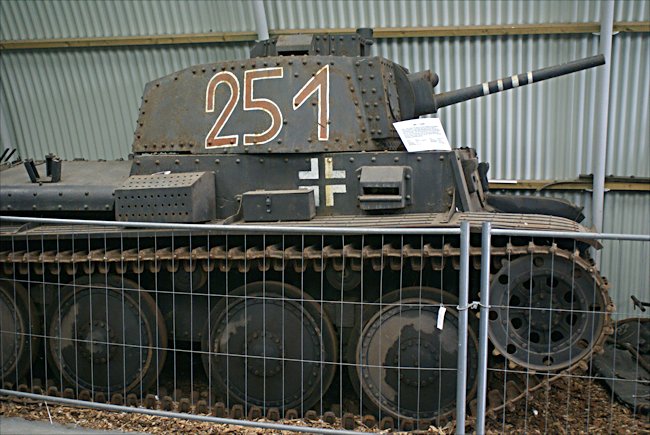
German Panzer 38(t) Tank
There is some confusion about the origins of this tank. It is part of the Becker Collection and is on loan to the museum. It is believed to be a reconstruction of a Panzer 38(t) using the tank chassis of a Swedish Army Stormartillerivagn m/43 105mm SPG Assault Gun (SAV m/43). The Swedes built Panzer 38(t) tanks under license during WW2. The tank version was called Stridsvagn m/41 Tank (Strv m/41). The turret and gun look different from a standard Czech built Panzer 38(t) but is similar to a Panzer stellung turret. They were the tank turrets used in ground fortifications.
It is a good move for the For Freedom Museum to display this tank as it does look like the Panzer 38(t) tanks that invaded Belgium in May 1940. Visitors can get a better understanding of the type of vehicles used by the invading German army. This tank was superior to the German Panzer I and II that made up a large chunk of the German Army. The Belgiums only had a few obsolete WW1 Renault FT tanks, French ACG-1 tanks, T-15 tanks and a Carden Loyd T13 assault gun to defend the country.
Skoda made tanks for the German Army!
In 1939 the German Army Panzerwaffe 1st Light Division received about 130 Czech Skoda 35(t) tanks, that had been developed from the British Vickers six ton tank. The Allies were now going to pay for their diplomatic sellout of Czechoslovakia. This new tank was known as the Panzer 35(t). It was superior to the Panzer Mark I and Mark II tanks that were the mainstay of the German tank force at this time.
The Panzer Battalion 67 of the 3rd Light Division was also issued with these Czechoslovakian tanks. One of its company commanders commented, after live firing Putlos ranges on the Baltic coast, "Our tanks were very good at cross-country but the armour was very weak and the radio fits primitive. The commander's and gunner's vision when the turrets were closed down was poor. They were still better than the Panzer Mark I and II." During the Munich negotiations over the Sudatenland Britain tried to buy the whole Czech LT-35 tank fleet from the Czechoslovak government, not because they thought it was a brilliant tank but primarily to deny them to Germany.
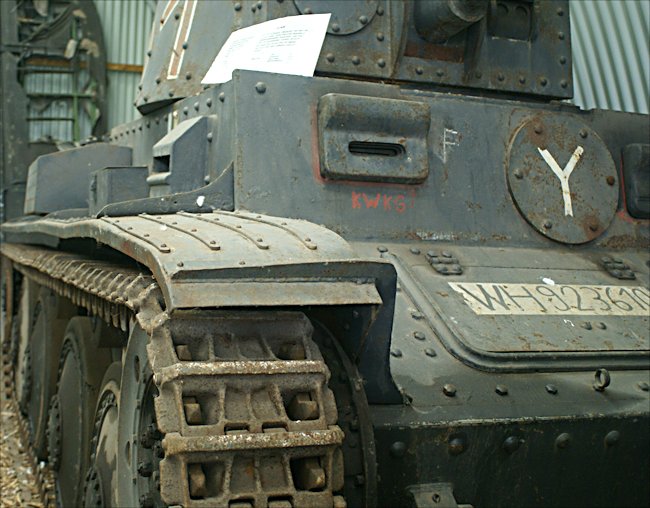
Notice that the Panzer 38(t) Tank's armour was riveted not welded.
The Panzer 38 (t) tank's role in the Battle of France May 1940
The Panzer 38 (t) tank was powered by 125 hp engine. It was an excellent well armoured light tank. It had 50 mm of armour at the front much more than other German tanks. Over 400 Panzer 38 (t) tanks took part in the blitzkrieg attack during the battle of France May 1940.
It had a 37 mm gun, the same calibre of gun as used by the infantry anti-tank teams of the German army. This was adequate in confronting the British and French light and medium tanks at short ranges but could not penetrate the thick armour of the French heavy tanks like the char B1 and the British Matilda. Its shells just bounced off frontal armour.
The only way the Panzer 38 (t) could the deal with these big heavy tanks of the allies was to attack them like Wolfpack at close range, surround them, and shoot them in their flanks and rear, whether armour was weaker.
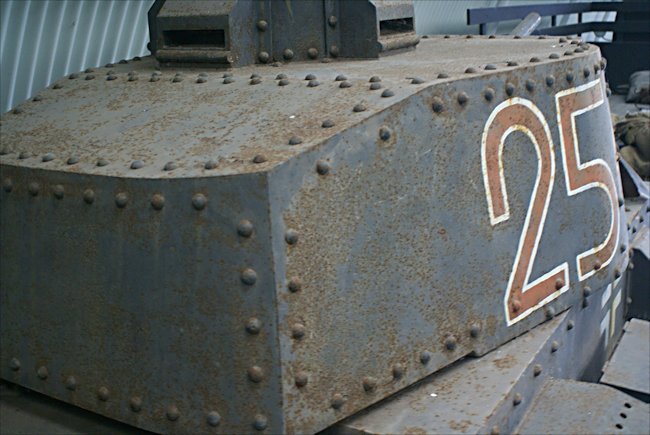
Riveted armour plate was weaker than welded tank armour.
German army tank crews the called the Panzer 38 (T) tanks,' Skodas'. German General Guderian, commanding the 19th Panzer Corps, recorded that ,574 tanks were available for the attack of France. The Anglo-French force outnumbered his strength. They had 4,000 tanks available. On paper 30% of this strength consisted of medium and heavy tanks that the German guns could not penetrate.
Almost 10% of Hitler's tank force that was going to be part of the blitzkrieg attack on France, was in fact manufactured in Czechoslovakia. The 6th Panzer Division was issued with 106 PzKpfw 38(t) tanks. This was recorded on the regimental reports dated 18 October 1939. 228 Panzer 38(t) tanks were assigned between the 7th and 8th Panzer Divisions. Rommel commanded the 7th Panzer Division. It was nicknamed the 'Ghost Division' because it was everywhere and single-handedly captured 450 enemy tanks
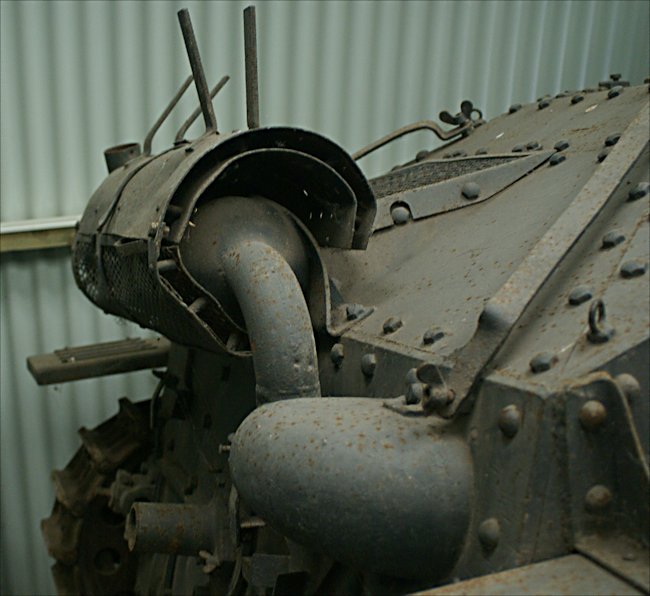
German Panzer 38(t) Tank exhaust system
The 6th Division were highly efficient during the battle of France, striking across the River Meuse towards the English Channel. They covered 217 miles in nine days. They had moved into Wester Woods, based of the Rhine at the beginning of March 1940 ready to take part in operation sickle cut; the armoured thrust through the Ardennes is into France. The Skodas belonging to first lieutenant Dr Franz Bakes 1st company, 65th Panzer Battalion, spearheaded the attack on the River.
Unhindered by the French air force, the 37 mm guns on these tanks supported by assault guns armed with the short 75 mm guns, poured fire onto the French defences across the River. They forded the River on 13 May 1940 losing just one tank which sank. Over the next three days, his company accounted the seven French tanks.
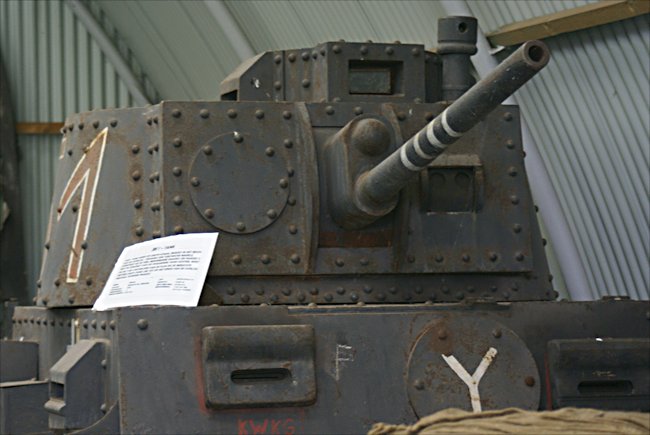
The rivited armour plate on the turret of a German Panzer 38(t) Tank
On 16 May 1940 they came up against the French armour counter-attack. Four days later they encountered the British 36th Brigade. Despite the mechanical shortcomings the 6th Panzer's 38(t) tanks gave a good account of themselves when they cross swords with the formidable French heavy tank char B1-bis belonging to the 2nd Division Cuirassee (2 DCR).
The Germans realised that there underpowered 37 mm guns could not penetrate the front armour of these heavy French tanks. They rushed the tanks and surrounded them. Firing at their weak spots. It took numerous hits to knock out one of these monsters.
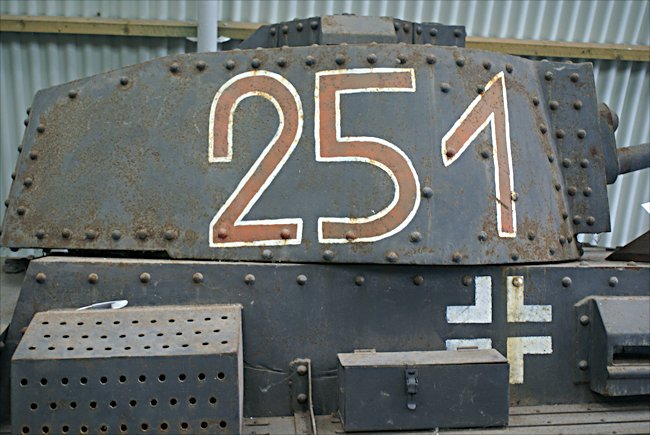
Rommel’s Panzer 38(t) tanks rush the Dinant bridge
Part of Panzer General Erwin Rommel and Heinz Guderian’s May 1940 Blitzkrieg battle plan was to rush the crossings over the Meuse River in Belgium. He insisted that his men must be there within five days from the start of the attack. He was counting on his tanks rushing past the unsuspecting guards of an intact bridge, or on arriving at the river so quickly that, while the attack would not be a surprise the enemy soldiers already dug in, their thrust would take place before reinforcements from eastern and central France had arrived.
An attempt was made at 4pm on 12th May 1940 near Dinant. Other bridges over the River Meuse had been blown up during the previous day. From the heights that looked down on the valley, officers from Rommels 7th Panzer Division saw with glee that the bridge below them had not been blown.
Four Panzer 38(t) tanks were ordered to immediately to dash down the hill and capture the bridge before the engineers could ignite the explosives attached to the stone arches. This troop of tanks were commanded by Captain Steffen, 7th Panzers.
His driver Private Michael Berthold described what happened, "Steffen and I were like members of the same family. We had worked together in tanks since 1936. We had been to Austria and fought in Poland together, and now we were in Belgium. I called Steffen ‘the chief, and everyone referred to me as ‘Steffen’s bride’ because we were that close."
"During the attack I would drive to his four-man Czechoslovakian Panzer 38(t) down the cobbled streets of Dinant to the bridge. But as we drove through the main shopping street we were shot at from the butcher’s shop on out left by an anti-tank gun."
"The shell made a hole in the tank, and it hit Steffen in his throat, severing his jugular vein. I only discovered later, after I had driven the tank to safety. At the time I only knew he was wounded because I felt him fall on to the back of my neck. Our Gunner was also wounded. His head was split open."
"I could not hear what was going on behind me since it was noisy. I carried on driving towards the bridge, not realising that some of the tanks behind me had been shot up as well. I got within ten yards of the bridge before it exploded. I then had to turn around quickly, and drove back out of the firing line and looked after my friends bodies. The River Meuse was eventually crossed at the Houx lock and weir which was poorly guarded."
ww2 tank books

